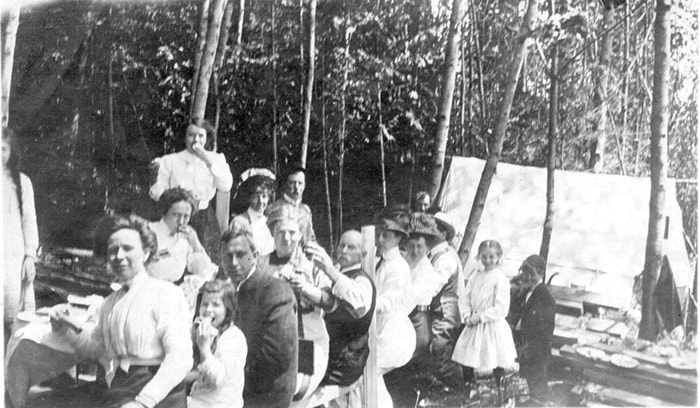The origin of the word picnic is not certain, but one source says it can be traced back at least to 1692.
Generally, the two basic conditions on such occasions were that they be held outdoors, and that everyone was expected to pitch in to provide the meal.
Obviously, the setting also was a great attraction, and White Rock’s waterfront fit the bill even before a permanent community was established.
In the early days, groups, ranging from the Bartenders’ Union (with 500 members attending) to the Salvation Army, to the rabbit breeders, organized picnics to enjoy the natural beauty of White Rock’s foreshore or the several camping grounds, such as Bradshaw’s near the train station or Jones Park at the east end of town.
As early as 1914, Henry Thrift’s annual Sunday School picnic, held near the Semiahmoo First Nation land, welcomed 50 children to a day at the seaside. White Rock beaches were also extremely popular for Surrey public school picnics during the 1920s. A thousand pupils were expected to attend in 1922.
Decades later, a unique community picnic was prompted by a mischief-maker on a March night in 1950 when the iconic ‘white rock’ was painted black. After much agonized discussion, the Board of Trade, sponsors of the project to clean the paint off the rock, invited the public to make a picnic of the affair.
For longtime residents, not much equals the nostalgia aroused by the mention of outings originating from White Rock Pier, aboard the Lady Alexandra or one of her sister ships bound for Victoria or Bowen Island.
The first venture, billed as a businessmen’s picnic excursion, to Victoria in 1931, was the brainchild of White Rock realtor George Thrift, who convinced Surrey council to declare the day a civic holiday. The event was such a success that the following year the steamship was chartered to sail under the Surrey Citizens Picnic banner.
By 1940, the civic holiday had become the norm, “to enable citizens of Surrey to attend the Surrey Municipality Annual Basket Picnic.”
Reminiscent of Leacock’s Mariposa Belle, the vessel typically arrived in White Rock about 6:30 a.m. to sound its whistle every 15 minutes until it left the pier at 8 a.m., reaching Victoria at 12:30 p.m.
The day-trippers were back in White Rock at 9:30 p.m. The round trip cost $2.
After a lapse of six years during wartime, the “Lady Alex” once more steamed into White Rock in 1947, ready to transport eager excursionists to Victoria. In 1949, the ANAF sponsored excursion to Victoria attracted 650 passengers.
Often, the ship was under the command of Captain Billy Yates, a sometime resident of White Rock.
A colourful character, he was renowned for having the orchestra play Aloha Oe repeatedly on the trip home.
In The Good Company, author Tom Henry gives this picture of Yates: “Aboard the Lady Alex, Cappy Yates had his own set of rules – often at variance with those of the company. Union Steamships insisted on ship limits, but under Yates, the Lady Alex, licensed for 1,400 passengers, often carried 2,000.
The company also wanted ships to arrive and depart on time. Captain Yates arrived and departed when he felt like it. Once he even held up an entire ship so a crew member could retrieve a child’s hat.”
He adds, “the relationship between Cappy Yates and the Lady Alex lasted throughout the 1930s and ’40s. By 1951 the cruise and excursion business was falling off, a result of an increasing fascination with the automobile for holiday transportation and an improved highway system.”
In 1952, the “Lady Alex” was withdrawn from service, and converted to a floating restaurant.
Once a month, for several years after retirement, Yates would journey from White Rock for a morning visit to the ship. In 1966, he died suddenly while cleaning his son’s swimming pool.
Although the family requested no flowers, one wreath was allowed, from Lady Alexandra.
• • •
Community picnics may be passe, but on a sunny summer’s day, White Rock’s waterfront is packed with folks replicating, in their own fashion, Omar Khayyam’s vision: “A book of verse beneath the bough, A loaf of bread, a jug of wine, and thou…”
The Peninsula’s best-known mother-and-son historians, Lorraine and Hugh Ellenwood, are dedicated to preserving history through the White Rock Museum & Archives. Call 604-541-2225, or email whiterockarchives@telus.net
